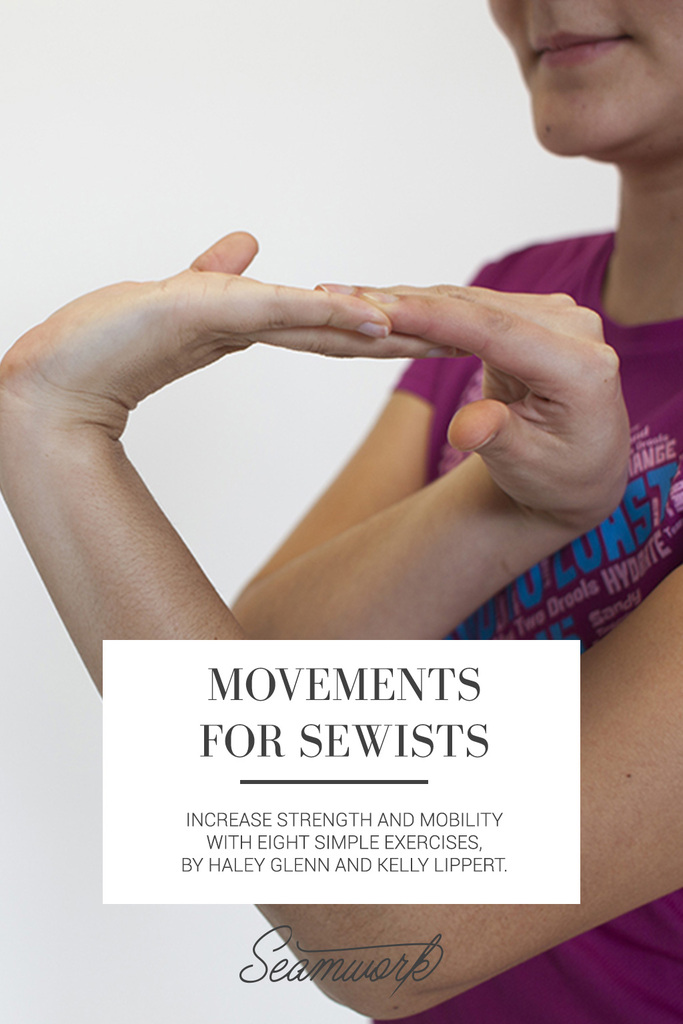When I first began sewing, I was struck by how physical of an activity it was. I approached sewing with a ferocious appetite to learn everything there was to be learned. I would lay in bed at night shoulders and back aching, obsessing over sleeves and welt pockets. A few years into my sewing career, I was up late sewing a jacket when I felt one of the worst pains I had ever experienced. It shot from my shoulder through my arm like fire, causing me to double over with pain. I went to bed, hoping the pain would subside, only to wake up the next morning feeling worse. A quick trip to urgent care informed me that I had pinched a nerve, caused from a prolonged period spent hunched over a sewing machine.
Since that day, I have taken greater care to treat my body kindly when sewing. Athletes train to support the range of motion and activities they participate in, why do we as sewists not do the same? I spoke with Kelly Lippert, co-owner of Quantum Fitness in Palm Desert, California, about how sewists can gain strength and mobility to better their bodies.
Kelly has been comprehensively trained in many modalities including Pilates, Gyrotonic, and kettlebells. She has been working as a fitness professional for over seventeen years. She preaches balance and self-love, and aims to make all the people she works with feel their best in both body and mind. I might be bragging a bit, because she is also my mother.
Sewing is an innately forward activity. Whether you are executing a full bust adjustment or sewing a facing, most sewists find themselves regularly hunching over their project. Kelly suggests a combination of three different movements to increase strength and mobility: flexion, extension, and rotation. This trio will strengthen your core, which will better support your spine and help maintain healthy spine mobility.
You should always consult a health-care professional before starting this or any other fitness program. Always work within your own range of limits and abilities.
Flexion
In terms of the spine, flexion is the act of bending in a forward motion. Flexion is important for maintaining mobility and strength, and is key to maintaining a health spine.
Ab Curl
Benefits: core, abdominal, and back strengtheningHow to:
Lay on the floor flat on your back. Knees are up and bent so that the hip is approximately forty-five degrees, and feet are on the floor.
Interlace your hands at the base of your skull.
Exhale: Slowly lift the head, neck, and shoulders off the floor with control.
Inhale: Return to the starting position.
Repeat eight times.
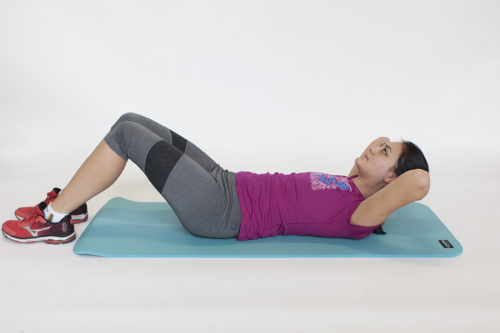
NOTES OF MOVEMENT:
Do not apply any pressure with the hands behind the neck. Keep your chin away from your chest and your neck long.
Banana
Benefits: core strength, oblique strength, lateral flexion.How to:
Lie on your side with all body parts lined up so that your ankles, knees, hips, shoulders, and ears are in one line.
Move your legs slightly forward imitating the shape of a banana (Ha! Get it!?).
Stretch the bottom arm out long and lay your head down.
Make sure your abdominals are pulled in and up. This the key to using the abs for strength and stability.
Inhale: The breath moves down the full length of your spine, making your entire body very long from tip to toe.
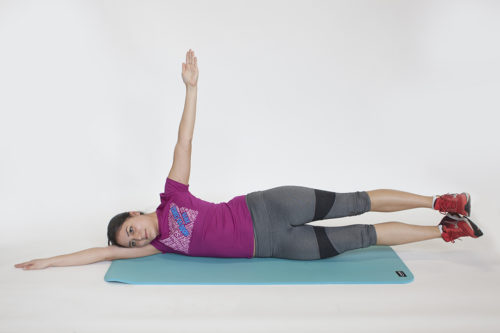
Exhale: Use your abdominals, obliques, and the engagement of your legs to bring both legs up a few inches off your mat.
Inhale: Slowly lower your legs back down on the mat. Use control.
Repeat eight times on each side.
Frog Legs
Frog legs strengthens your core while in a neutral spine.
Benefits: Core strength, strengthen neutral spine, supports good posture.
How to:
Inhale: Lay on your back with your legs bent upward, so that your knees are roughly aligned with your pelvis. Have your knees apart and your heels pressed firmly together.
Your stomach should be tight with your lower back imprinting against the mat. Imagine squeezing your stomach into your spine. Your shoulder blades flat on the mat and hands down by your side.
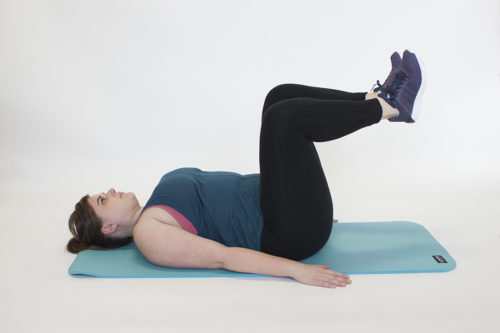
Exhale: Slowly lengthen your legs up and away while maintaining the pressure on your heels.
Inhale: Move back to the starting position, continuing to maintain the pressure between your heels.
Repeat eight times.
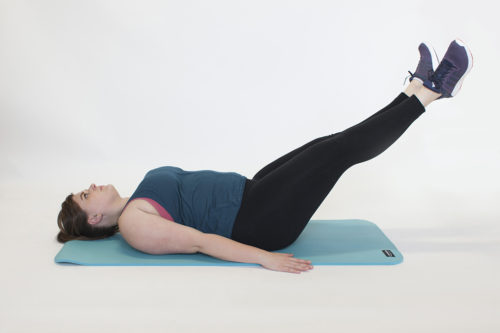
Extension
Extension is the opposite of flexion. Extension is the action of bringing the body backward, in the opposite motion of forward bending. Remember when executing extension to keep your abdominal pulled up and in to support the spine. Shoulders should be depressed and kept engaged. Extension is especially good for those with osteoporosis but should always be executed with care.
Baby Swan/ Cobra
Benefits: Strengthens back, counteracting our modern forward posture.
How to:
Lie face down with your forehead flat on the mat. Your arms should be bent with elbow held close to your side, and your palms facing down by your ears. Keep a comfortable distance between the legs with heels facing one another. Pull your navel up and press your pubic bone down into the mat.
Inhale: Maintaining your starting position.
Exhale: Scoop your belly in, squeeze your bum, and slowly rise up from your upper back keeping your forearms on the mat. Keep your neck long as you lift from the mat.
Inhale: Hold this position for the length of the breath.
Exhale: Return to the starting position.
Repeat eight times.
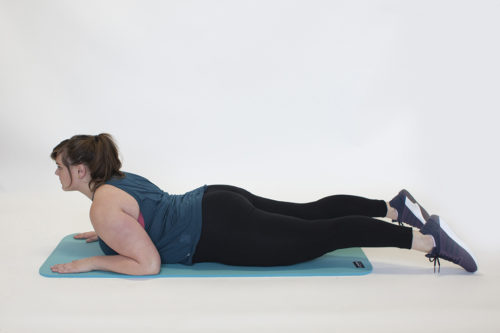
Wrist Flexion
Benefits: Keeps the range of motion in your hands and wrist through strengthening and stretching.
How to:
This exercise can be done either sitting or standing.
With your left hand, gently bend your right hand at the wrist.
Hold for 10 seconds.
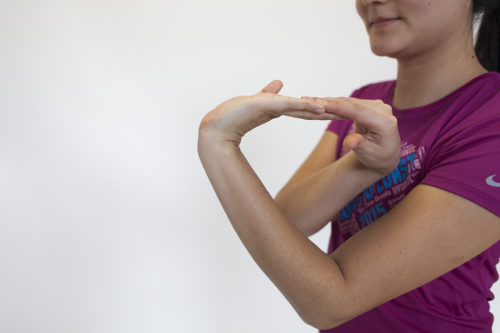
Clasp Hands Behind Back Stretch
Benefits: Stretches pectoral and shoulder muscles, releasing the body from the forward position.
How to:
Begin by standing tall with feet hip-width apart.
Clasp your hands behind your back with palms facing each other.
Keep your neck and spine long, reaching the crown of your head toward the ceiling.
Hold for ten seconds.
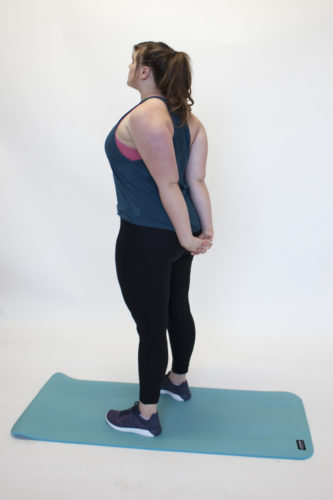
Rotation
Rotation is the twisting of the spine on its axis.
Spine Twist
Benefits: Supports spinal mobility
How to:
Sit on the mat with legs together in front of the body and feet flexed. Raise arms comfortably to the side and shoulder height. Sit tall through the spine.
Inhale: Elongate the spine, reaching the crown of your head to the ceiling.
Exhale: Twist the torso to the right, pulsing two times.
Inhale: Return the torso to center.
Exhale: Twist the torso to the left, pulsing two times.
Inhale: Return to center.
Repeat eight times on each side.
NOTES ON MOVEMENT: Keep your feet together and avoid scissoring the feet as you twist.
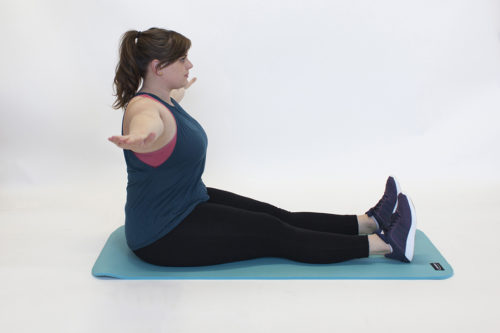
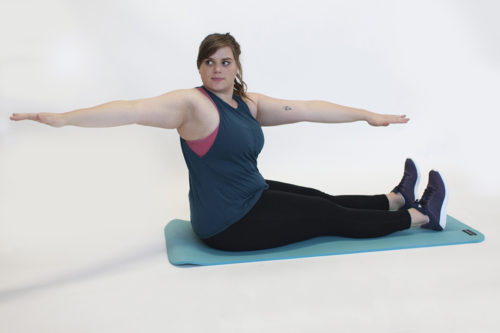
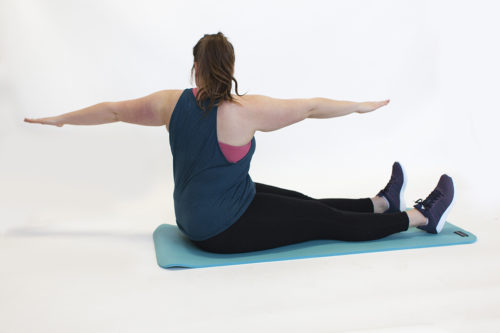
Thread the Needle
This exercise combines flexion, extension, and rotation.
Benefits: Combines many motions, including rotation and hip flexion, arm and wrist strength, and shoulder mobility.
How to:
Begin on your hands and knees. Place your wrists directly under your shoulders and your knees directly under your hips. Point your fingertips to the top of your mat. Place your shins and knees hip-width apart. Center your head in a neutral position and soften your gaze downward. This is called, “table pose.”
Exhale: Reach your right arm up toward the ceiling, pressing strongly away with your left hand. Next, reach your right arm underneath your table and slide your right arm underneath your left arm with your palm facing up. Let your right shoulder come all the way down to the mat. Rest your right ear and cheek on the mat, then gaze toward your left.
Keep your left elbow lifting and your hips raised. Do not press your weight onto your head; instead, adjust your position so you do not strain your neck or shoulder. Let your upper back broaden. Soften and relax your lower back. Allow all of the tension in your shoulders, arms, and neck to drain away.
Hold for up to one minute.
Inhale: To release, press through your left hand and gently slide your right hand out. Return to table pose. Then repeat the pose on the opposite side for the same amount of time.
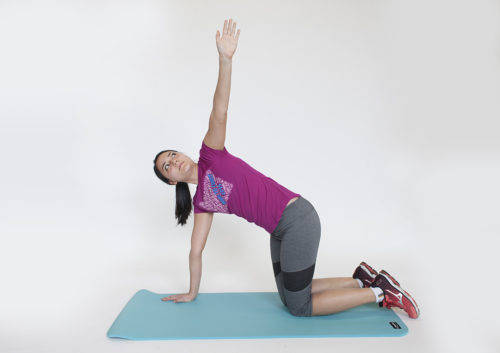
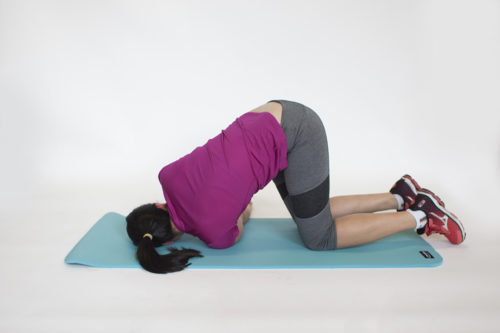
This pose stretches and opens the shoulders, chest, arms, upper back, and neck. It releases the tension that is commonly held in the upper back and between the shoulder blades. This pose also provides a mild twist to the spine, which further reduces tension.



